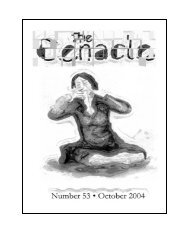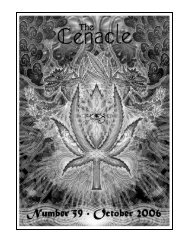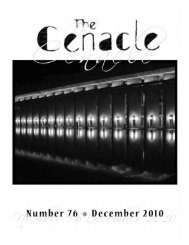Joe Ciccone - The ElectroLounge
Joe Ciccone - The ElectroLounge
Joe Ciccone - The ElectroLounge
You also want an ePaper? Increase the reach of your titles
YUMPU automatically turns print PDFs into web optimized ePapers that Google loves.
22<br />
their bulging dicks. At best, they’re womanizers: “the philandering Pierre” in one book, Pronek<br />
the Conqueror in another, the fornicator Pryanishnikov in Tolstoy’s story “<strong>The</strong> Devil.”<br />
If they’re not womanizers, sexual P men are out-and-out perverts like polygamists,<br />
prowlers, peeping Toms, pederasts, and pedophiles. Or they’re passive gay men: poofs, ponces, punks,<br />
pansies, formerly called spintries, pogers, pathics, and prushuns. (<strong>The</strong>y haunted male brothels<br />
called spearhouses.) <strong>The</strong> title character of Portnoy’s Complaint is a compulsive masturbator. Joyce<br />
Carol Oates’ character Quentin P. is a child molester. So is Brian Prentice in Will Self’s novel<br />
<strong>The</strong> Butt, who horrifies the story’s decent hero Tom Brodzinski: “He found himself repeating his<br />
companion’s name over and over in his mind: Prentice, Prentice, Prentice. . . . Until consonants<br />
were ground down, and Tom was thinking: penis, penis, penis.”<br />
Randy women can be P characters too. <strong>The</strong> devil in Tolstoy’s story isn’t Mr.<br />
Pryanishnikov, it’s his friend’s mistress Stepanida Pechnikov. Until the Sexual Revolution, any<br />
extramarital sex earned women a P. <strong>The</strong> adulteress in <strong>The</strong> Scarlet Letter (1850) is Hester Prynne.<br />
Honor Tracy’s novel Settled in Chambers (1967) has both a Prue living in sin with a divorced<br />
artist and a presumed adulteress named Mary Price. Too much dick, you see—but women<br />
also get P names if they’re not getting any dick, like spinsters. As the feminist Kate Millett<br />
asked, “Aren’t women prudes if they don’t and prostitutes if they do” You bet, and the letter<br />
P has always been there to mock them. Ancient Greek for ‘virgin’ and ‘whore’ were parthenos<br />
and porne; in modern French they’re pucelle and pute. Whores get the worst of it, of course.<br />
Over the centuries, English terms for prostitutes have included public women, parnels, punks,<br />
paphians, pinchpins, and spoffokins. <strong>The</strong>ir bosses are pimps, panders, and procurers.<br />
If you trace these chains of associations back to their source, you will see that all<br />
of these words are essentially phallic. <strong>The</strong> chief chain of associations is a short and terrible<br />
one that we all learn to understand quite early in life: ‘phallus‐vagina‐whore’, or prick-pussyprostitute.<br />
Many languages besides English can reproduce this chain with P words alone, often<br />
in several different ways: Latin penis-pudenda-prostituta, Indonesian peler‐pukas-perek, Spanish<br />
pene-potorro-puta, or pijo-papaya‐pelandusca, and Polish penis-pochwa-prostytutka, or even<br />
praçie-pipa-pipa (pipa being both ‘pussy’ and ‘slut’). 9 Don’t blame the letter; the fault lies in<br />
human misogyny, which seems to be bred in the bone.<br />
VIII. <strong>The</strong> Purple Weenie<br />
Does every language have a P word for penis No. But those that do generally have<br />
the same kind of line-up as English: the formal word is Latin penis, then there’s a slangy P<br />
equivalent like prick or pecker, and then various other words with different first letters (schlong,<br />
dick, etc.). In German, for example, the line-up is Penis, Pimmel, Schwanz. In Danish it’s penis,<br />
pik, diller. In Hungarian it’s pénisz, pöcs, fasz. In Indonesian it’s penis, peler, burung. You get the<br />
idea. <strong>The</strong> slangy P words are the interesting ones because they’re all different: modern Greek<br />
poutsa, Yiddish putz, French pine or popol, Afrikaans piel, Romanian pula. Spanish is awash in<br />
regional variants: polla, pijo, pija, pinga, pito, pico; and so is Portuguese: pau, pica, pinto, piça,<br />
pila, picha, pichota, pistola, piroca.<br />
English does pretty well too: prick, pecker, peter, pee-pee, and so on. For some<br />
numbers, let’s consider Deborah Cameron’s 1992 article “Naming of Parts.” She collected<br />
182 ‘penis’ terms from American college students of both sexes. 10 Twenty percent have P (or<br />
sp-) onsets: that’s 37 terms, the most for any letter. (<strong>The</strong> next most frequent onsets are M, W,<br />
<strong>The</strong> Cenacle | 84 | April 2013









